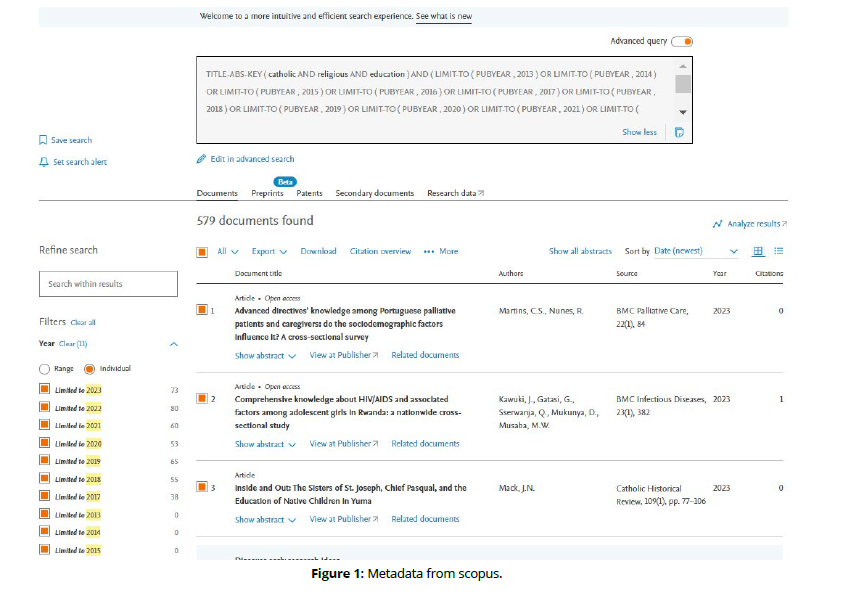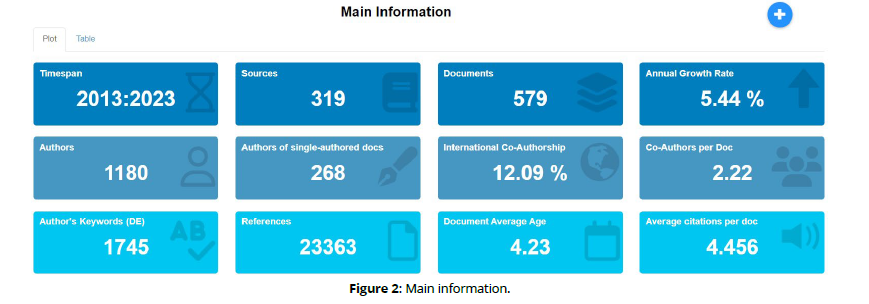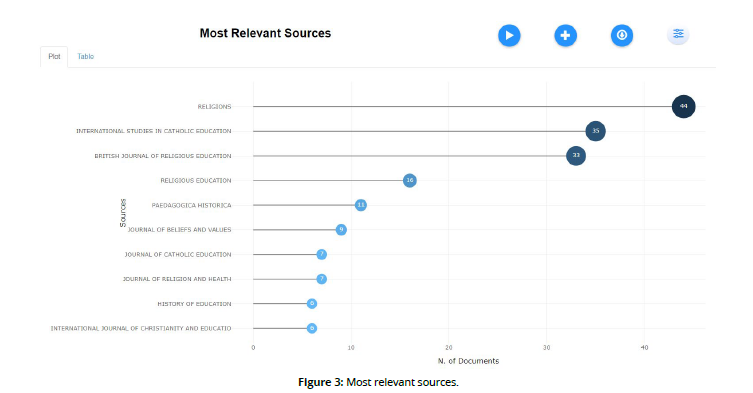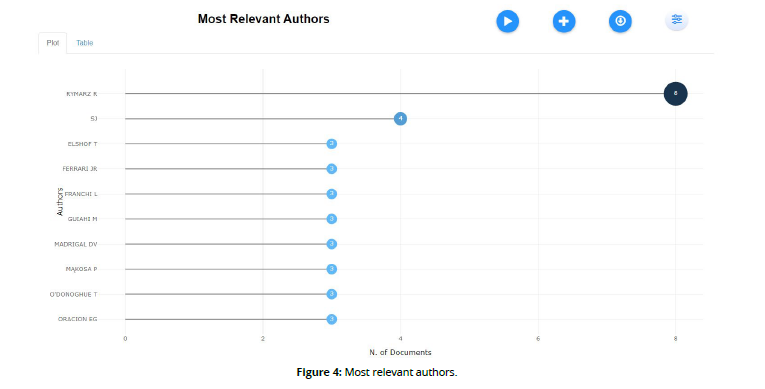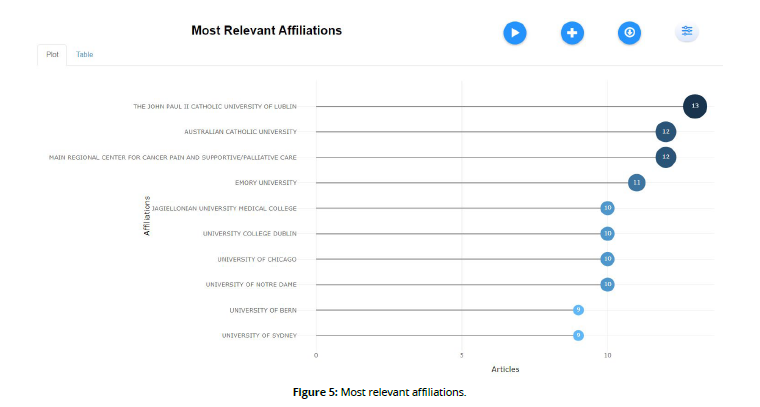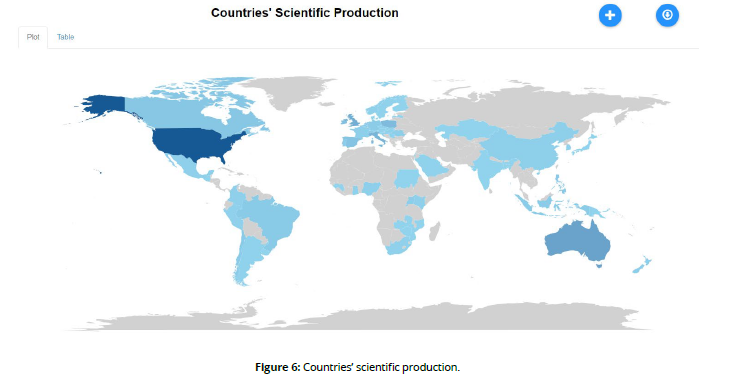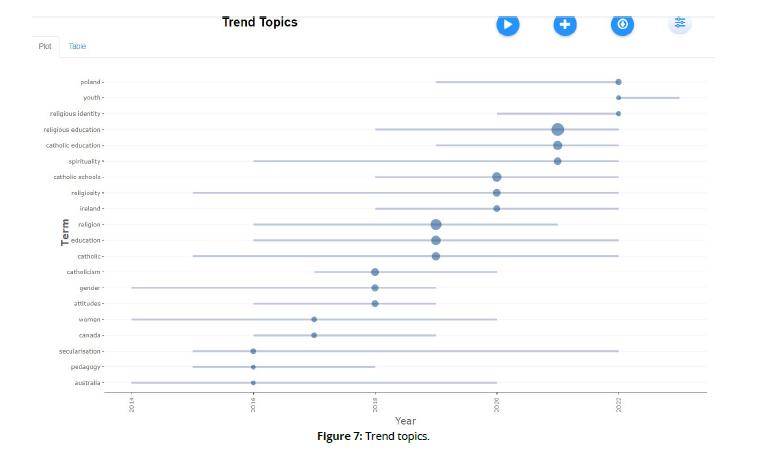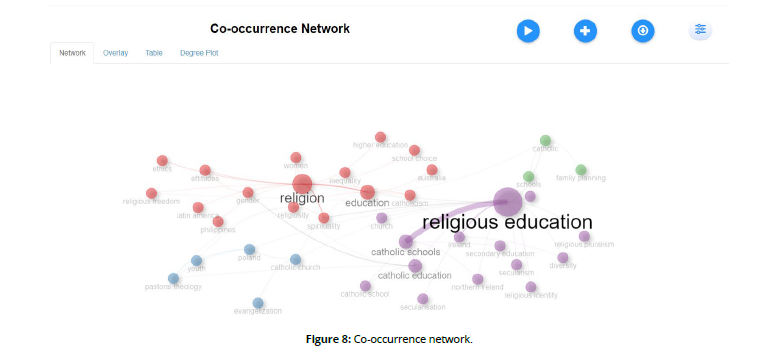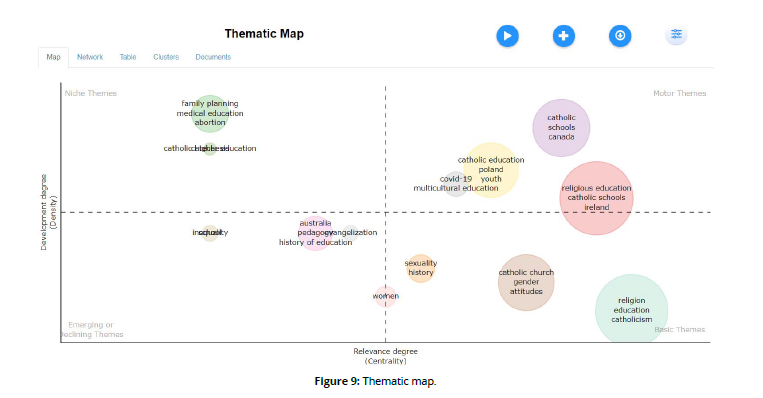Full Length Research Article - (2023) Volume 18, Issue 5
Mapping Research Trends In Catholic Religious Education Bibliometric Analysis
FR Wuriningsih*, Soesanto, YL Sukestiyarno and Titi Prihatin*Correspondence: FR Wuriningsih, Universitas Negeri Semarang, Semarang, Indonesia, Email:
Received: 06-Oct-2023 Published: 20-Oct-2023
Abstract
To understand developments and trends in Catholic Religious Education research, this article presents a comprehensive bibliometric analysis. The analysis was conducted between 2013 and 2023 using data from the Scopus database, with 579 documents identified. The results of this analysis reveal a significant growth trend in the number of publications related to Catholic Religious Education, reflecting the growing interest in this discipline. Countries such as the United States, Australia, and the United Kingdom played an important role in the contribution of this research. In addition, keywords that often appear in the literature involve basic concepts such as "religion," "education," "Catholicism," "religiosity," and "spirituality." International collaboration has also proven to be a hallmark in Catholic Religious Education research, illustrating the global nature of Catholic religious education and the cooperation between countries active in developing a global understanding of the discipline. This article not only provides a comprehensive mapping of research trends in Catholic religious education, but also identifies important implications for further research, curriculum development, and policymaking in Catholic religious education. As such, this bibliometric analysis provides valuable guidance for researchers, education practitioners, policymakers, and all those interested in developing Catholic religious education that is relevant and grounded in strong values in the context of a changing society.
Keywords
Bibliometrics. Catholic religion. Research trends
Introduction
Catholic religious education has become an inseparable part of the worldwide Catholic education system (Pollefeyt, 2021; Groome, 2020). With a focus on teaching Catholic religious values, ethics, and beliefs, Catholic Religious Education plays an important role in shaping an individual's character, morality, and spirituality. Over the past few decades, this field has undergone significant and increasingly complex developments (Roebben, 2019; Dineen, 2021). In the midst of the dynamic development of society, the scientific literature on Catholic Religious Education continues to develop, reflecting the evolution of values and challenges faced by this religious education (Rossiter, 2018; Rymarz, 2022). To gain a deeper understanding of developments and trends in Catholic Religious Education research, the bibliometric analysis method has become a very useful approach. Bibliometric analysis allows the collection, measurement and analysis of robust data about the scientific literature in a discipline, helping us identify trends, contributions and developments within the field.
In this context, this article aims to map research trends in Catholic Religious Education through comprehensive bibliometric analysis. In the period from 2013 to 2023, the Catholic Religious Education literature has undergone significant changes in terms of coverage, approach, and issues discussed. Our bibliometric analysis aims to provide in-depth insight into how this literature has evolved over time. Through this article, we will dig into bibliometric data obtained from the Scopus database to identify significant research trends, understand the contributions of different countries in the field of Catholic Education, identify the most frequently used keywords, and describe patterns of international collaboration in this literature. This analysis will help open the door to a deeper understanding of the development and direction of research in Catholic Religious Education.
We hope that the findings from this bibliometric analysis will make an important contribution to the understanding of the literature and developments in Catholic Religious Education, which can provide valuable guidance for researchers, education practitioners, policy makers, and all parties interested in this field. Through a better understanding of trends and research focuses, we can help strengthen and direct the development of Catholic religious education for a better future grounded in strong values.
Research methods
In an effort to understand trends and developments in Catholic Religious Education research, we conducted a comprehensive bibliometric analysis. Bibliometric analysis is a powerful approach to measuring and analyzing the existing scientific literature within a field of research, focusing on characteristics such as number of publications, prolific authors, frequently published journals, most commonly used keywords, and more (Sumiharsono et al, 2023; Andriyani, 2023). In the context of this study, we aim to reveal a deep understanding of how research in Catholic Religious Education has evolved from 2013 to 2023. Our research data is obtained from the Scopus database, a reliable source of information in the scientific literature. We designed a meticulous search query to identify documents relevant to the study. Our search query is as follows:
TITLE-ABS-KEY (catholic AND religious AND education) AND (LIMIT-TO (PUBYEAR, 2013) OR LIMIT-TO (PUBYEAR, 2014) OR LIMIT-TO (PUBYEAR, 2015) OR LIMIT-TO (PUBYEAR, 2016) OR LIMIT-TO (PUBYEAR, 2017) OR LIMIT-TO (PUBYEAR, 2018) OR LIMIT-TO (PUBYEAR, 2019) OR LIMIT-TO (PUBYEAR, 2020) OR LIMIT-TO (PUBYEAR, 2021) OR LIMIT-TO (PUBYEAR, 2022) OR LIMIT-TO (PUBYEAR, 2023)) AND (LIMITTO (DOCTYPE, "ar")) AND (LIMIT-TO (SRCTYPE, "j")) AND (LIMIT-TO (LANGUAGE, "English"))
This search ensures that we only get documents of type "Articles" (DOCTYPE "ar") published in scientific journals (SRCTYPE "j") in English. By searching for specific keywords like "catholic," "religious," and "education," we were able to explore literature specifically focused on Catholic Education. After conducting a search, we managed to collect as many as 579 documents relevant to this research topic. The next step is to make a selection of data to ensure that the documents we will analyze are really relevant to our research. We include articles that cover research and exploration of concepts relevant to Catholic Religious Education.
The data we collect is then analyzed in depth using diverse bibliometric metrics. We will examine research trends that develop from year to year, identify the most prolific authors in this field, analyze journals that frequently publish research in Catholic Religious Education, explore the most frequently used keywords, and provide an overview of the development of literature in this field. The results of the bibliometric analysis will be shown in the "Results" section of this article, where we will discuss the main findings, we have obtained and provide a deeper understanding of research trends in Catholic Religious Education during our research period. Through this method of bibliometric analysis, we hope to make important contributions to the understanding of literature and developments in Catholic Religious Education, which can help researchers, practitioners, and academics to see a more complete picture of the field (Figure 1).
Analysis results
Main information
Main Information refers to the main information or basic information that provides an overview of a particular topic, subject, or topic. This primary information is often used as a foundation or starting point to better understand or explore more in-depth matters related to the topic being studied (Figure 2).
The image provides a variety of information related to bibliometric analysis in the time span of 2013 to 2023 for literature relevant to Catholic Religious Education. The number of documents identified was 579, consisting of articles published in various sources such as journals, books, and the like. The annual trend of interest in research in this field during the period. The average age of the document, which indicates when it was first published, is 4.23 years. These documents have an average of 4,456 citations per document, demonstrating the significance and influence of this literature in broader research. There are a total of 23,363 references in this literature, demonstrating the depth of research relevant to this topic. In addition, there are 1,059 additional keywords used in the indexation (Keywords Plus) and 1,745 keywords created by authors (Author's Keywords), highlighting the diversity of aspects explored in this literature. There are 1,180 authors contributing to these documents, of which 268 are single authors resulting in 285 single documents. The average number of coauthors per document was 2.22, which suggests collaboration is fairly common in the study. In addition, about 12.09% of such collaborations are international collaborations, indicating the international nature in academic contributions in Catholic Religious Education.
Most relevant sources
Most Relevant Sources refers to those sources of information or references that are most relevant or important in a particular context. These sources are information that is most appropriate or of high value in understanding, supporting, or developing a particular topic, research, or task. In this analysis, researchers used sources from journals.
Figure 3 describes the sources that most often place publication in the Catholic Religious Education literature. The main source dominating in the number of publications is "Religions" with 44 articles related to this topic. It is followed by
"International Studies in Catholic Education" with 35 articles, which is also an important source in Catholic Religious Education literature. The "British Journal of Religious Education" took third place with 33 related articles. Furthermore, there are sources such as "Religious Education" with 16 articles, "Paedagogica Historica" with 11 articles, and "Journal of Beliefs and Values" with 9 articles that also contribute to this literature. In addition, the "Journal of Catholic Education" and "Journal of Religion and Health" each have 7 articles related to this topic. Other sources such as "History of Education" and "International Journal of Christianity and Education" also contributed a significant number of articles, with 6 articles each. This data reflects the diversity of sources that form the basis of literature in Catholic Religious Education, covering various aspects of education and research in the context of Catholicism.
Most relevant authors
Most Relevant Authors refer to those authors who are considered most relevant or important in a particular field of research or discipline. These authors have significant contributions to the development of science and research in a particular topic, and are often recognized for their expertise, knowledge, or influential works.
Figure 4 presents information on the most prolific authors in Catholic Religious Education-related literature, along with the number of articles they contributed. RYMARZ R is the most prolific writer with 8 articles he has written. Followed by SJ with 4 articles, showing a significant contribution in this study. In addition, there are a number of authors who have written 3 articles each, such as Elshof T, Ferrari Jr, Franchi L, Guiahi M, Madrigal Dv, Mąkosa P, O'donoghue T, and Oracion Eg. The diverse contributions of these authors reflect the diversity of approaches and topics present in the Catholic Religious Education literature, as well as the impact of their contributions on the development of knowledge in this discipline.
Most relevant affiliations
Most relevant affiliations refer to the most relevant or important affiliations or associations within a particular field, industry, or discipline. These affiliates are often universities, institutions, organizations, or entities that have a significant role in supporting, developing, or directing developments in the field. In the context of this study, affiliation mostly refers to campus.
Figure 5 reflects the affiliations of institutions most active in contributing to the Catholic Religious Education literature. The John Paul II Catholic University of Lublin leads the list with that affiliation, contributing with 13 articles. Australian Catholic University and the Main Regional Center for Cancer Pain and Supportive/Palliative Care shared second place with 12 articles each. Institutions such as Emory University, Jagiellonian University Medical College, University College Dublin, University of Chicago, and the University of Notre Dame each have 10 articles related to this topic. The University of Bern and the University of Sydney each contributed 9 articles. These data reflect the diverse range of institutions involved in research and publications in the field of Catholic Education, suggesting that collaboration across academic institutions is common in the development of literature in this discipline.
Countries’ scientific production
Countries' Scientific Production" refers to the scientific output or production produced by various countries around the world in various disciplines. This scientific output includes studies published in scientific journals, conference articles, books, and various other types of scientific publications. Analysis of the scientific production of these countries is important in understanding the contribution and influence of a country in the world of research and science (Figure 6).
Based on the data, countries that produce a lot of articles on topics related to Catholic Religious Education vary greatly in the number of their contributions. The United States stood out as a major contributor with 327 articles, demonstrating a dominant role in the study. It is followed by Australia with 126 articles, which ranks second in contributions to the scientific literature in this area. The UK with 98 articles ranked third on the list, signifying the significant contribution of this country which has a long history in Catholic education. In addition, Italy, Poland, and Ireland also produced sizable numbers with 78, 62, and 52 articles, respectively. Countries such as Spain, Canada, the Philippines, and the Netherlands were also seen participating in the study with varying numbers of articles. As such, these data illustrate the diversity of global contributions in Catholic Religious Education, reflecting the topic's importance in international contexts as well as its diverse cultural and academic heritage.
Trend topics
Trend Topics refers to topics or subjects that are in the spotlight or become a popular conversation in a certain period of time. "Trend Topics" are a reflection of the interests, attention, and talks that were dominant in scientific publications at the time (Figure 7).
This figure presents a list of keywords or topics related to bibliometric trends in the Catholic Religious Education literature. The keyword "Poland" reflects the focus on the situation of Catholic Religious Education in Poland. It covers educational research, policies, and practices related to Catholicism in the country. "Religious identity" refers to research and studies related to the religious identity of individuals, especially in the context of Catholic Religious Education. It covers how Catholic religious education influences the formation of religious identity. "Youth" refers to research related to youth or the younger generation in the context of Catholic religious education. This may include the study of Catholic education for youth, challenges faced by youth in developing religious beliefs, and the like. "Religious education" is a central topic in Catholic Religious Education literature. It includes the study of teaching methods, curricula, and approaches in Catholic religious education in schools and educational institutions. "Catholic education" includes research that focuses on the Catholic education system in general. This includes the study of Catholic schools, Catholic educational institutions, and their impact on society and students. The entire list of keywords in this table reflects the diversity of topics relevant to Catholic Religious Education, covering aspects such as religious identity, religious education, Catholic schools, and the influence of Catholicism in various social and cultural contexts in countries such as Poland, Ireland, Canada, and Australia.
Co-occurrence network
Network co-occurrence is an important concept in data analysis and network science. It refers to the visual representation of relationships between elements that often appear together or "co-occur" in a given context. In this context, such elements can be words in text, entities in data, or even concepts in research (Figure 8).
The figure shows a grouping of topics by cluster number. There are four different clusters with related topics, and here is the narrative for each cluster: Cluster 1: The first cluster consists of topics related to religion, education, and related social issues. It covers topics such as "religion," "education," "catholicism," "religiosity," "spirituality," "gender," "attitudes," "higher education," "women," "Australia," "ethics," "Latin America," "Philippines," "school choice," "inequality," and "religious freedom." The cluster describes various aspects related to Catholicism, education, ethics, and social issues in different countries. Cluster 2: The second cluster consists of more specific topics related to the Catholic church and its influence in different countries. It covers topics such as "catholic church," "poland," "youth," "evangelization," and "pastoral theology." The cluster highlights the focus on the role of the Catholic church in society and pastoral care in a particular country. Cluster 3: The third cluster is specifically related to the topics of "catholic" and "schools." It reflects research and studies related to Catholic schools and education in the context of Catholicism. Cluster 4: The fourth cluster covers a wide range of topics related to Catholic religious education in several countries, such as "Ireland," "Canada," "catholic school," "secularisation," "secularism," "Northern Ireland," "religious identity," "religious pluralism," "secondary education," "church," and "diversity." This cluster focuses on research related to the Catholic education system, religious identity, religious pluralism, and social change in various countries. Each cluster reflects a different focus of research in the Catholic Religious Education literature, with each cluster having relevant and specific topics. These clusters help organize different topics and research approaches within this discipline.
Thematic map
Thematic Map is an important tool in communicating information about the distribution of certain topics or variables in a study. "Thematic Map" is used to visualize data and describe patterns or trends related to a particular topic or theme (Figure 9).
Map thematic analysis is used to see the opportunities of a research trend based on density and centrality. Density itself means density, if the density line goes up, the more research (trends, issues, and reference documents). Meanwhile, centrality relates to how significant a theme with the larger theme being studied. The more to the right of centrality, the theme is considered substantial and influential. The picture above shows the results of the thematic analysis of the map and is divided into four topic quadrants based on density and centrality: 1). The topic in the upper right quadrant is interpreted as a relevant and widely researched topic, 2). The topic in the lower right quadrant shows relevant and deserves to be researched more deeply, 3). The theme in the upper left quadrant is a theme that shows less relevance and has rarely been studied or even has been studied too much, 4). Furthermore, the theme in the lower left quadrant indicates that the topic is declining (Sari et al., 2022).
Discussion
Catholic religious education is one of the important aspects of individual education and development based on Catholic religious values (Van der Kooij, 2017; Chan, 2015; Gleeson, 2023). In an attempt to uncover research trends and developments in Catholic Religious Education, bibliometric analysis became an effective tool for understanding the evolution of scientific literature in this discipline. Through this research, we aim to present a deeper understanding of how Catholic Religious Education literature has evolved from 2013 to 2023. Our bibliometric analysis revealed significant growth trends in Catholic Religious Education research over the period studied. The number of publications related to this topic has seen a consistent increase, reflecting the ever-growing interest in this field (Safitri, 2023; Asriyani, 2023). This improvement covers various aspects, including a deeper understanding of Catholic values-based education, evaluation of teaching methods, and the impact of Catholic religious education on individuals and society.
The results of the bibliometric analysis also revealed the role of diverse countries in contributing to Catholic Religious Education research. The United States, Australia, and the United Kingdom stand out as the countries most active in producing publications related to this topic. The contributions of these countries reflect their commitment to Catholic education and their important role in developing a global understanding of Catholic religious education. The keywords that appear most frequently in the Catholic Religious Education literature include topics such as "religion," "education," "catholicism," "religiosity," and "spirituality." From this analysis, we can conclude that the literature in this field often highlights the basic concepts of Catholicism and how they are integrated in an educational context. In addition, an in-depth understanding of gender roles in Catholic religious education and individual attitudes towards faith-based education is also a significant topic.
Bibliometric analysis also reveals that international collaboration is quite common in Catholic Religious Education research. The collaboration includes authors from different countries who contributed to the study. This reflects the global nature of Catholic education and the cooperation among researchers that results in richer insights into the Catholic Religious Education literature. This discussion provides an in-depth understanding of the contribution and role of Catholic Religious Education in global education and community development. The results of this bibliometric analysis can provide valuable guidance for researchers, education practitioners, and policymakers to direct future research and development in Catholic Religious Education. With a better understanding of trends and a focus of research, we can continue to improve Catholic religious education for a better, values-based society. Thus, this bibliometric analysis not only maps research trends, but also provides a basis for further improvement and development in this field.
Although this bibliometric analysis provides a deep understanding of research trends in Catholic Religious Education, it also has some limitations to note: 1. Data Limitations: This study is based on data obtained from the Scopus database. Although Scopus is a reliable source of scholarly information, it is possible that some relevant publications may not be included in this database. In addition, the data only includes publications in English, so publications in other languages can be missed. 2. Time Limitations: This analysis is limited by the time period from 2013 to 2023. Therefore, research trends before 2013 or after 2023 will not be reflected in this study. This may limit understanding of long-term developments in Catholic Religious Education. 3. Search Category Limitations: Although our search queries are designed to cover various aspects of Catholic Religious Education, it is still possible that some relevant topics or keywords may not be included in this search. Broader or specific search categories may yield different findings. By understanding these limitations, readers can more wisely interpret the results of this study and use them as a basis for further research in Catholic Religious Education.
Conclusion
In the bibliometric analysis that has been carried out to describe research trends in Catholic Religious Education over the period 2013 to 2023, several key findings have been identified. First, there is a significant growth trend in the number of publications related to Catholic Education, reflecting the growing interest in this field. The United States, Australia, and the United Kingdom emerged as the country’s most active in producing related research. The keywords that appear most frequently in the literature include topics such as "religion," "education," "catholicism," "religiosity," and "spirituality." In addition, international collaborations proved to be quite common in Catholic Religious Education research, demonstrating cooperation between countries in developing a global understanding of Catholic religious education. The results of this bibliometric analysis have several important implications for further research and development in Catholic Religious Education: 1.
Development of Research Focus: These findings can help researchers to identify the most relevant and important topics in Catholic Religious Education. This can be the basis for the development of a more in-depth research focus in this discipline. 2. International Collaboration: The high level of international collaboration in Catholic Religious Education research demonstrates the importance of sharing knowledge and experience between countries. Further research can leverage cross-border cooperation to gain richer insights and a deeper understanding of Catholic religious education across a variety of contexts.
Curriculum Development: These findings may assist educators and policymakers in developing Catholic religious education curricula that are more relevant and responsive to trends and developments in the scientific literature. 4. Policy Development: Policymakers can use the results of this analysis to help formulate more effective education policies based on relevant scientific literature. 6. Continued Research: These findings provide a solid basis for continued research in Catholic Religious Education. More in-depth research on certain topics, evaluation of teaching methods, and the influence of Catholic religious education on society can be useful research directions. In conclusion, this bibliometric analysis provides a comprehensive view of research trends in Catholic Religious Education. All this is expected to contribute to the better and sustainable development of Catholic religious education, as well as enrich the literature and global understanding of the discipline.
References
Andriyani, D., Puspitasari, S., Chandrawati, T., & Ramadhan, S. (2023). Research Trends in the Last 3 years Related to Distance Education: A Bibliometric Study. Jurnal Paedagogy, 10(2), 544-553.
Asriyani, S., & Ramadhan, S. (2023). Analisis Bibliometrik: Kurikulum Pada Pendidikan Anak Usia Dini Berdasarkan Database Scopus Tahun 2014-2023. AWLADY: Jurnal Pendidikan Anak, 9(2), 132-143.
Chan, F. N. K. (2015). Religious education in Hong Kong Catholic schools: Past, present and future. Global perspectives on Catholic religious education in schools, 131-142.
Dineen, F. (2021). Religious Education in Catholic Schools: Troubling Times or Routine Ructions?. In Irish and British Reflections on Catholic Education: Foundations, Identity, Leadership Issues and Religious Education in Catholic Schools (pp. 187-198). Singapore: Springer Singapore.
Gleeson, J. (2023). Integrating faith-based perspectives across the curriculum in Queensland Catholic schools: the potential of Catholic social teaching. International Studies in Catholic Education, 1-16.
Groome, T. (2020). Religious education in Catholic schools to educate for living faith. Journal of Christian Education in Korea, 61, 37-60.
Pollefeyt, D. (2021). Teaching the Unteachable or Why Too Much Good Is Bad. Religious Education in Catholic Schools Today. Religions, 12(10), 810.
Roebben, B. (2019). New wine in fresh wineskins. Rethinking the theologicity of Catholic religious education. Global Perspectives on Catholic Religious Education in Schools: Volume II: Learning and Leading in a Pluralist World, 51-61.
Rossiter, G. (2018). Religious Education: Where to from Here? Reflections on the Trajectory of Australian Catholic School Religious Education 1965–2017. Christian Faith, Formation and Education, 181-196.
Rymarz, R. (2022). Investigating the work of school based religious education leaders in Australian catholic schools. Religious Education, 117(1), 50-60.
Safitri, D., & Ramadhan, S. (2023). Tren Riset Media Kartun dalam Pendidikan Berdasarkan Database Scopus Tahun 2000-2023: Analisis Bibliometrik. Jurnal Basicedu, 7(3), 1757-1767.
Sumiharsono, R., Nasaruddin, N., Safrudin, M., & Ramadhan, S. (2023). Research Trends On Character Education Based On Scopus Database From 2018 To 2023: A Bibliometric Analysis. Edukasi Islami: Jurnal Pendidikan Islam, 12(02).
Van der Kooij, J. C., de Ruyter, D. J., & Miedema, S. (2017). The merits of using “worldview” in religious education. Religious Education, 112(2), 172-184.
